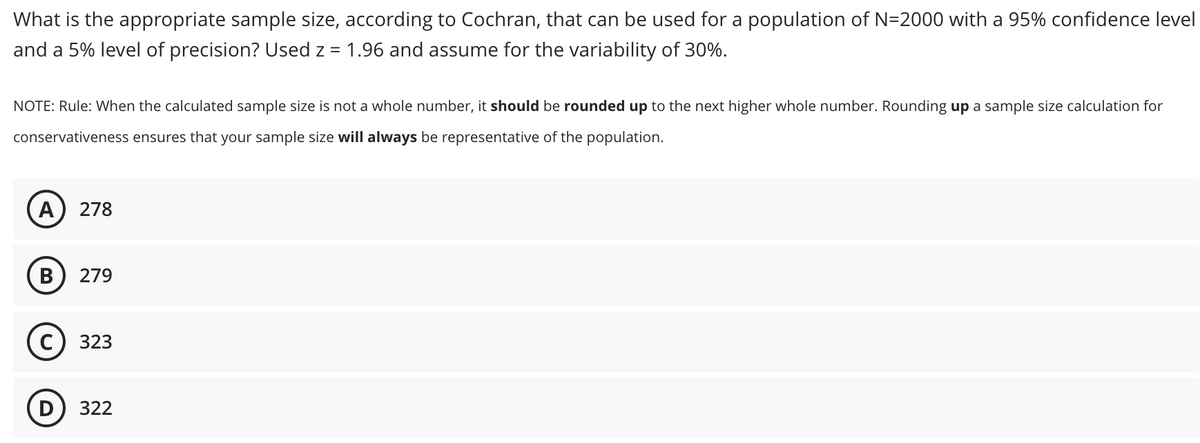What is the appropriate sample size, according to Cochran, that can be used for a population of N=2000 with a 95% confidence lev and a 5% level of precision? Used z = 1.96 and assume for the variability of 30%. NOTE: Rule: When the calculated sample size is not a whole number, it should be rounded up to the next higher whole number. Rounding up a sample size calculation for conservativeness ensures that your sample size will always be representative of the population. A) 278 B) 279 C) 323 D) 322
What is the appropriate sample size, according to Cochran, that can be used for a population of N=2000 with a 95% confidence lev and a 5% level of precision? Used z = 1.96 and assume for the variability of 30%. NOTE: Rule: When the calculated sample size is not a whole number, it should be rounded up to the next higher whole number. Rounding up a sample size calculation for conservativeness ensures that your sample size will always be representative of the population. A) 278 B) 279 C) 323 D) 322
MATLAB: An Introduction with Applications
6th Edition
ISBN:9781119256830
Author:Amos Gilat
Publisher:Amos Gilat
Chapter1: Starting With Matlab
Section: Chapter Questions
Problem 1P
Related questions
Question
HELP PLS. ASAP

Transcribed Image Text:What is the appropriate sample size, according to Cochran, that can be used for a population of N=2000 with a 95% confidence level
and a 5% level of precision? Used z = 1.96 and assume for the variability of 30%.
NOTE: Rule: When the calculated sample size is not a whole number, it should be rounded up to the next higher whole number. Rounding up a sample size calculation for
conservativeness ensures that your sample size will always be representative of the population.
A 278
B 279
C) 323
(D) 322

Transcribed Image Text:The average (arithmetic mean) of a list of 6 numbers is 20. If we remove one of the numbers, the average of the remaining numbers
is 15. What is the number that was removed?
A None of the above
B 45
D
30
35
Expert Solution
This question has been solved!
Explore an expertly crafted, step-by-step solution for a thorough understanding of key concepts.
Step by step
Solved in 2 steps

Recommended textbooks for you

MATLAB: An Introduction with Applications
Statistics
ISBN:
9781119256830
Author:
Amos Gilat
Publisher:
John Wiley & Sons Inc

Probability and Statistics for Engineering and th…
Statistics
ISBN:
9781305251809
Author:
Jay L. Devore
Publisher:
Cengage Learning

Statistics for The Behavioral Sciences (MindTap C…
Statistics
ISBN:
9781305504912
Author:
Frederick J Gravetter, Larry B. Wallnau
Publisher:
Cengage Learning

MATLAB: An Introduction with Applications
Statistics
ISBN:
9781119256830
Author:
Amos Gilat
Publisher:
John Wiley & Sons Inc

Probability and Statistics for Engineering and th…
Statistics
ISBN:
9781305251809
Author:
Jay L. Devore
Publisher:
Cengage Learning

Statistics for The Behavioral Sciences (MindTap C…
Statistics
ISBN:
9781305504912
Author:
Frederick J Gravetter, Larry B. Wallnau
Publisher:
Cengage Learning

Elementary Statistics: Picturing the World (7th E…
Statistics
ISBN:
9780134683416
Author:
Ron Larson, Betsy Farber
Publisher:
PEARSON

The Basic Practice of Statistics
Statistics
ISBN:
9781319042578
Author:
David S. Moore, William I. Notz, Michael A. Fligner
Publisher:
W. H. Freeman

Introduction to the Practice of Statistics
Statistics
ISBN:
9781319013387
Author:
David S. Moore, George P. McCabe, Bruce A. Craig
Publisher:
W. H. Freeman